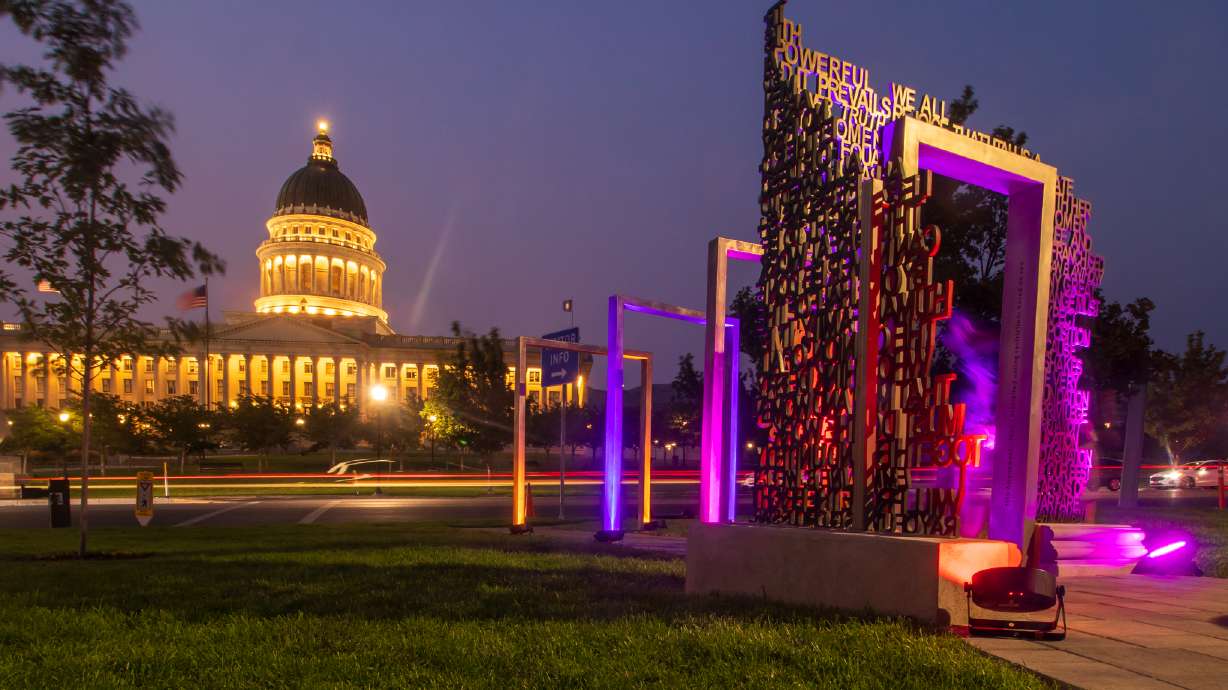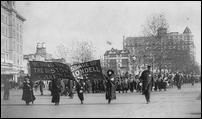Estimated read time: 10-11 minutes
This archived news story is available only for your personal, non-commercial use. Information in the story may be outdated or superseded by additional information. Reading or replaying the story in its archived form does not constitute a republication of the story.
SALT LAKE CITY — As the sun set beneath a smoke-filled sky Thursday evening, a group aimed to make Utah women’s history more well-known unveiled their latest project designed to remember a movement in Utah, and around the country, to make voting more open to U.S. citizens.
It’s a memorial that wraps together the origins of the women’s suffrage movement, from its beginnings in 1848 to Seraph Young’s historic vote in 1870 to laws passed to increase voting equality for people of all color and gender in the 1900s. Thursday’s celebration happened on the heels of the 100th anniversary of the final state needed ratifying the 19th Amendment, which gave millions of women the right to vote at that time.
Better Days 2020 officially unveiled the artwork during a ceremony outside of the Salt Lake Council Hall building across the street from the Utah Capitol. It adds to the number of monuments and memorials that tell the story of Utah all around the Capitol.
The artists behind the work, Kelsey Harrison and Jason Manley, explained how they absorbed as much feedback as they could to tie in the most Utah and U.S. women’s historical references as possible.
For us, what that meant was holding the vision and the ambition and beauty of the suffragists’ dream for equity at the same time we’re holding the shortcomings of that vision — and not letting either sit out of balance from one another, to hold those things at the very same time.
–Kelsey Harrison, artist
There was originally a struggle of mixing history with contemporary art ideas, Manley said. They decided the piece would be something a visitor can experience, not just look at. He hopes that it will inspire future generations to appreciate the power and importance of voting.
"It was about creating an interactive site and an environment, as opposed to a monolithic statue; as opposed to one big object that you kind of look at," he said. "This piece, you’re invited to walk into and experience and sit with, and other possible ways of engaging in talks about democracy."
Harrison acknowledged that trying to tie together voting equality history to represent everyone is difficult. That’s because its history is messy and there are many aspects that could have easily been overlooked. For example, a monument devoted solely to Utah territory allowing women to vote in 1870 or the 19th Amendment in 1920 would overlook the reality that many men and women of color didn’t have the right to vote at that time.
"For us, what that meant was holding the vision and the ambition and beauty of the suffragists' dream for equity at the same time we’re holding the shortcomings of that vision — and not letting either sit out of balance from one another, to hold those things at the very same time," she said. "This piece, for us, while it marks the landmark achievement of suffragists, it’s also meant to embody the attitude of suffrage, which is to reject the reality where equity is in name only."

The two worked on the project at a time when historic memorials and monuments were uprooted during protests of systemic racism and discussions of what should be remembered in public monuments. In fact, protests following the death of George Floyd while in police custody erupted at the Capitol as the construction of the project began.
One of the largest gatherings brought thousands to the lawn this new memorial now stands. The movement was something that wasn’t lost on Harrison, who added that it further inspired the work.
"To see that as this historical corridor linking not the subject of the protest — those are not the same — but the spirit of the protest, which is to say 'I do not accept a reality where equity is in name only, but demand its realization," she said.
What did they come up with?
Here’s a breakdown of the objects and different meanings you can find at the memorial the next time you visit the Utah Capitol.
Council Hall
This both is and isn’t a part of the memorial, but the building has significance to women’s suffrage history. When Young became the first woman to cast a vote in a modern election open to both men and women, she did it inside the Salt Lake Council Hall building.

It’s not at the same location where she voted in 1870, but it is the same building in which she cast her historic vote. The building originally stood at 110 S. State in the heart of downtown when it was constructed in the 1860s. In the 1960s, it was moved up to its current location across the street from the Utah Capitol. It became a National Historic Landmark in 1975.
Bronze footprints

When you reach the memorial, you’ll see a few things. A table and doors stand out the most. But there are also bronze boot prints jetting out from the building to the rest of the memorial’s features. One of the prints is engraved with “Seraph Young 1870” to reference her vote in an equal election for men in women held in Salt Lake City on Feb. 14, 1870.
The table and chairs
There’s a pair of meanings to a table and chairs set the prints lead to, said Neylan McBain, CEO of Better Days 2020. The table represents the origin of the modern women’s suffrage movement, which began with the publication of the "Declaration of Sentiments" in 1848.
McBain said the tea table is something similar to what Elizabeth Cady Stanton and Lucretia Mott would have sat at in Seneca Falls, New York, as they wrote the influential document urging the right to vote for women. The document was introduced at Seneca Falls Convention soon after, where it was signed by about 100 attendees.
"It was really the first official effort and document that requested voting rights for women," McBain said.

It would be another two decades until Wyoming became the first territory to allow women the right to vote; although, Utah is where the first equal vote was cast.
The chairs at the table are a reference to Utah's state constitution in 1895. The U.S. stripped Utah women’s right to vote in 1887 under a federal anti-polygamy law. Five years later, leaders began crafting their constitution as the territory neared statehood.
McBain explained they are bronze replicas of the chairs that are in the Salt Lake City council room in the Salt Lake City-County Building. That’s significant because it was in that room and on those chairs that the leaders drafted the constitution, which included reinstating women’s suffrage in Utah. When Utah became a state on Jan. 4, 1896, it became just the third state that allowed women to vote.
Engraved on the tea table is Article 4 of the state constitution as it was originally written. It reads: "The rights of citizens of the State of Utah to vote and hold office shall not be denied or abridged on account of sex. Both male and female citizens of the State shall enjoy equally all civil, political and religious rights and privileges."
McBain called it a "really cool passage" because of how specific it was that rights wouldn’t be denied based on gender. It was also written at a time where the vast majority of other states didn’t allow women to vote.
"It’s a powerful text that we were happy to add to that little theme there," she said.
Quotations

As you view the memorial north, you then come across four doorways. Before that, you’ll find a few quotations from Utah and U.S. suffrage leaders of all backgrounds, including different races and genders. They include quotes from people such as Susan B. Anthony, Emmeline B. Wells, Sojourner Truth, Franklin Richards, Sarah Kimball and more.
The quotes lead toward the passage of laws that fought for voting equality.
The four doorways
Thursday’s ceremony didn’t end with the unveiling of the memorial. After it was revealed, Dr. Jacqueline Thompson, a representative of the Utah Multicultural Commission, read a brief history of the memorial as descendants of five women who helped shape voting laws held photos of those women as they walked around the specific section of the memorial dedicated to the law they helped craft.

The four doors symbolize the advancement in voting laws from the women’s suffrage movement.
"It represents this threshold that women crossed from the private or domestic sphere, which is partially represented by the tea table and the chairs and sort of home-type setting, and it represents their movement out to public life," McBain said. "They broke down walls, essentially, that kept them in the domestic sphere."
Door 1: 19th Amendment
Ratified 100 years ago Tuesday, the 19th Amendment of the Constitution gave 27 million women in the U.S. the right to vote. As historians note, it still didn’t account for voting laws that banned or discouraged people of color to vote — and that’s why this door leads to three other doors in the monument.
Related:
Those doors expand as you walk through to represent how equality grew with the passage of each law.
Door 2: Indian Citizenship Act of 1924 and revisal of Utah laws in 1957
As noted by History.com, citizenship granted to Native Americans was limited up until the last 1800s, as the country typically only gave it to those with half or less native ancestry. A pair of laws in the 1888 and 1919 granted citizenship to Native American women married to U.S. citizens and, the latter, to World War I veterans.
Even though the 1924 law gave Native Americans citizenship, which allowed many to vote for the first time, it wouldn’t be until 1957 that Utah’s laws were adjusted to allow Native Americans on reservations access to voting, said Better Days 2020 historian Katherine Kitterman. Since there was that lapse, both years are represented on the doorway.
Door 3: Immigration and Nationality Act of 1952
Just last year, Utah celebrated the 150th anniversary of the transcontinental railroad. It was a feat assisted largely through the craft and speed of Chinese immigrants in the late 1860s. But many laws after the railroad’s completion made it difficult for Chinese immigrants to live in western states. It culminated in the Chinese Exclusion Act of 1882. Similar laws in the ensuing decades banned immigrants from other Asian countries.
These laws were repealed and many Asian-Americans were given citizenship and the right to vote in 1952.
Door 4: Voting Rights Act of 1965
While the 15th Amendment barred voting discrimination on the basis of race, skin color or previous slave status in 1870, historians point out there were many overlooked loopholes aimed to prevent Black men from voting. Some areas created poll taxes and literacy tests and used other tactics deliberately aimed to suppress voters. These continued well into the 20th century and after the 19th Amendment.
Poll taxes in federal elections were made illegal through the 24th Amendment in 1964, as noted by History.com. The following year, the Voting Rights Act banned other discriminatory tactics. Poll taxes in state elections were banned by the Supreme Court in 1966.
The pathway
The final piece of the artwork isn’t 1965; it’s the direction you’re heading, McBain said. If you pass through looking straight forward, your eyes will look dead center with the Utah Capitol. While national voting laws in 1920, 1924, 1952 and 1965 made suffrage open to more people, many argue there’s still work to be done.

That’s why the memorial leads toward the Utah Capitol. It’s where new laws can be crafted to make voting more accessible and open to everyone. Hence, the pathway is symbolic not only the progression of voting equality history but for its future as well.










